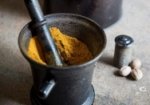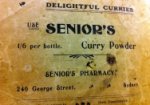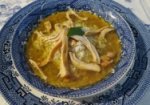In a world where the internet gives us access to the world twenty-four hours a day, and imported commodities arrive from across the globe by air and sea on a daily basis, it may come as a surprise, especially for our younger audiences, to know that a new ship in the harbour caused more than a ripple in the colonies of New South Wales. Each new arrival brought news from afar, fresh people to mix with in society, and coveted trade goods such as textiles, household items and ‘exotic’ food items that we now take for granted.
One of our core roles as a museum organisation is inviting primary and secondary students to our properties so they can participate in high-quality education programs that are designed to meet specific syllabus outcomes and run by professionally trained staff. Sydney Living Museums offers a wide range of education programs for Years 1 to 12, all of which can be found on our website in Education.
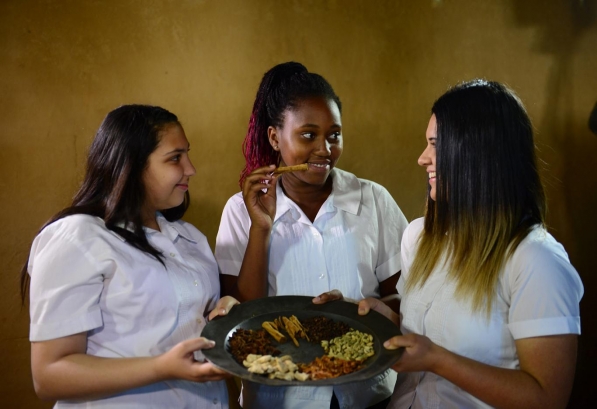
Stew to Stirfry students in the colonial kitchen at Elizabeth Farm. Photograph © Jeremy Piper for Sydney Living Museums
In the informal learning environment of our museums, students engage with unique historic artefacts and participate in hands-on education. For students of Food Technology we currently run two programs, one at Elizabeth Farm, From Stew to Stirfry* and the other at Vaucluse House, Pickled, Potted and Preserved. Both these programs have been specifically developed for Food Tech students and focus on addressing Outcomes and Content areas from the NSW Food Technology Year 7-10 Syllabus. *Please note, From Stew to Stirfry is no longer offered at Elizabeth Farm.
Both programs allow students to participate in numerous practical food-based activities, from tasting a range of indigenous and non-indigenous foods, to making butter or preserved lemons. They also enjoy numerous hands-on learning experiences within the historic setting of each property as they tour the grounds, explore the 19th century kitchens and much more.
Exotic tastes
In 1825 there were exotic ingredients for sale in Sydney’s various warehouses and shops that would surely have made dinner a more appealing experience if one had the means to buy them. Imports weren’t exactly flooding in, but even a quick scan of the Sydney Gazette shows that what was making it to the colony was rich in both variety and flavour.
This extract from 1825, which students use a primary reference source in the From Stew to Stirfry program, lists a range of ingredients on offer at a shop near Circular Quay on Pitt Street, “fish sauce, mustard, currie powder, cayenne pepper – spices of all kinds, ginger…” – just what you’d need to make a fine curry.
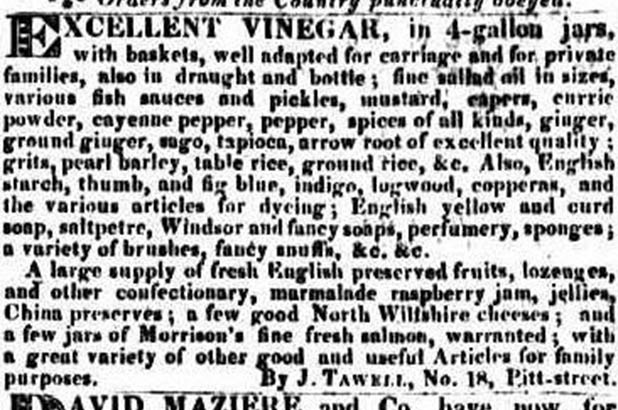
Advertisement, The Sydney Gazette and New South Wales Advertiser, 13 October 1825, p4. Retrieved September 10, 2013, from http://trove.nla.gov.au/ndp/del/article/2184521
Hidden meanings
Curry was a popular choice at Elizabeth Farm in the 1820s, as The Cook and the Curator explains in Curry Culture. This genuine connection with the colony and the Macarthur family gives us a wonderful opportunity to introduce Food Technology students to ingredients and recipes from this period of Australia’s food history.
At Elizabeth Farm students participating in From Stew to Stirfry* learn about the range of spices available in Australia at this time and identify where they originated from. They then make a curry powder from a 19th century recipe, learning about the notion of ‘eating the Empire’ – that the ingredients used in their curry powder reflect multiple regions, cultures and countries from all over the British Empire and that curry is a gastronomic display of British global dominance of the 19th century.
The recipe they follow is from The Cook’s Oracle, first published in 1817 by Dr William Kitchiner, as respected physician who understood that good cooking was vital to good health.
Put the following ingredients in a cool oven all night – and the next morning pound them in a marble mortar, and rub them through a fine sieve.
Coriander seed 3 oz
Turmeric 3 oz
Black Pepper, Mustard, and Ginger, 1 oz of each
Allspice and Lesser [green] Cardamoms, 1/2 oz ea
Cumin-Seed, 1/4 oz
Thoroughly pound and mix all together, and keep them in a well-stopped bottle.
Obs[ervation] – This receipt was an attempt to imitate some of the Best Indian Curry Powder, selected for me by a friend at the India House :- the flavour approximates to the Indian powder so exactly the most profound Palaticians have pronounced it a perfect copy of the original Curry Stuff.
OBS[ervation] – The common fault of curry powder is the too great proportion of Cayenne (to the milder Aromatics from which its agreeable flavour is derived), preventing a sufficient quantity of the Curry powder being used.
Food for thought
Students are then invited to take their curry powder with them, make their own curry (see recipe below) – in class or at home – and consider the following questions to further develop their understanding about this once exotic, but now common place dish.
- Do you think there is something missing from this curry recipe? What would you add?
- Did this curry taste different to a more modern curry? Why might this be the case?
- See if you can find out how curry was served 200 years ago – how might you serve yours today?
*Please note, From Stew to Stirfry is no longer offered at Elizabeth Farm.
Lamb curry with Dr Kitchiner’s curry powder
Ingredients
- 2 tablespoons cooking oil
- 1 onion, peeled and chopped
- 1 heaped tablespoon fresh ginger, finely chopped, optional
- 600g lamb shoulder meat, cut into 2 cm cubes (or preferred choice of meat)
- 2 tablespoons Dr Kitchiner's curry powder
- 1 tin diced tomatoes, chopped finely, and juice
- 1/2 teaspoon salt, or to taste
- fresh mint or coriander leaves (to serve)
- plain steamed rice (to serve)
- fruit chutney, optional (to serve)
Note
This curry recipe asks for lamb shoulder, which is an ideal cut of meat for a slow cooked curry. You can substitute using 'gravy beef' or chuck steak; chicken thighs can also be used, on or off the bone, but reduce cooking time to a maximum of an hour and a half.
Directions
| Heat the oil in a large, heavy-based saucepan over medium heat. Add the onion and cook gently until it is a light golden colour. Add the ginger and stir through for a minute or so. Add the lamb and cook, stirring, for a few minutes, until the meat starts to colour. Add 2 tablespoons of the curry powder, stirring to distribute it evenly through the meat. Be careful not to let the ingredients burn; reduce the heat if the curry starts to catch on the bottom of the pan, and add half a cup of water if it seems very dry. Cook gently for another 10 minutes, stirring to prevent the lamb and onions from sticking to the bottom of the pan. The curry should be fragrant and the meat starting to stew. Stir through the tomatoes and their juice, the salt and an additional 400 ml water. Cover the pan with a well-fitting lid and cook gently until the curry starts to bubble. Reduce the heat and simmer for 2–3 hours, adding more water if the liquid reduces below the level of the solids. | |
| To serve | |
| Transfer the curry to a serving dish and sprinkle with the chopped mint or coriander leaves. Serve with plain boiled or steamed long-grain rice and fruit chutney or pickle on the side, if desired. | |
Dr Kitchiner’s curry powder c1817
Ingredients
- 2 tablespoons turmeric
- 1 tablespoon ground coriander seeds
- 1 teaspoon ground mustard seeds
- 1/2 teaspoon ground black pepper
- 1/2 teaspoon ground ginger
- 1/4 teaspoon ground allspice
- 1/4 teaspoon ground cardamom
- 1/4 teaspoon ground cumin
- 1/4 teaspoon chilli powder, optional
Note
This recipe has been adapted from Dr Kitchiner's The Cook's Oracle, first published in 1817. You can use this curry powder to make any sort of curry – chicken, fish, vegetable or rabbit, which was very popular in the 1800s. You can also use it to make mulligatawny, a curry soup that stayed on Australian menus right up until the 1950s.
Dr Kitchiner warned that the overuse of chilli would spoil the aromatic quality of the curry. We've included chilli as an optional extra – you can determine the heat level depending on whether you use a mild or hot chilli powder.
Directions
| In a small bowl, stir all the spices together until evenly mixed. Store in the pantry in an airtight jar for up to twelve months. | |

Chinese export ware punchbowl featuring a scene of Sydney Cove before 1820. State Library of New South Wales: XR 10

 Print recipe
Print recipe